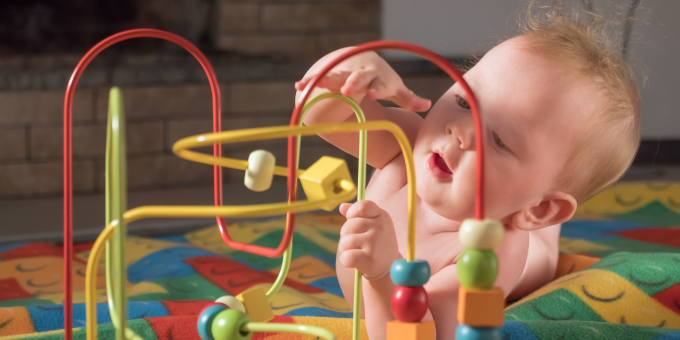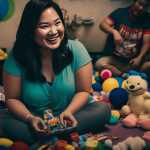
What is Autism Spectrum Disorder?
Autistic Spectrum Disorder (ASD) includes all the different types of disorders such as Asperger’s syndrome, Autism disorder and Pervasive Developmental Disorder (Not Otherwise Specified), also known as PDD (NOS) or atypical autism. Autism is characterised into 3 rankings, depending on the severity and level of support the person needs. Autism, refers to a broad range of conditions characterised by challenges with social skills, repetitive behaviours, speech and non-verbal communication. ASD usually begins before the age of 3 and lasts throughout a person’s life, however with appropriate early interventions, symptoms may improve over time. Some children with ASD show hints of future problems within the first few months of life. While for others, symptoms may not show up until 24 months or later. Some children with an ASD may still develop normally until around 18 to 24 months of age and then stay stagnant in acquiring new skills or even lose the skills they once had. It is important to know that some people without ASD might also show some of these symptoms. Children with ASD and sensory processing disorder (SPD) often overlap as they regularly struggle with processing sensory information. According to research statistics, over 90% of children with ASD have sensory issues.
How does sensory processing disorder affect children with ASD?
One of our Occupational Therapists (Claire) has highlighted key features of sensory processing disorder and how it can affect your child. To understand in-depth details about SPD, you can look into the blog focusing on SPD here.
In summary, children with sensory processing disorder can experience the following symptoms:
- Overall irritability
- Jumpiness and anxiety
- Temper tantrums
- Social isolation
- Unpredictable behaviors
- Rigidity
- Inattentiveness
- Easily distracted
- Slow processing abilities
- Trouble following instructions
- Balance, Coordination, Fine motor issues (vestibular)
As a result these symptoms can cause children with SPD to have difficulties in learning, interacting with people, participating in activities and completing activities of daily living (ADLs).
What is a Sensory Diet?
It is activities that are part of a child’s daily routine that help the child reach and maintain optimal level of arousal (energy) during his/her day, promoting self-regulation and behavioral organization. These activities impact the central nervous system and can either be alerting or calming for the child.
There are seven primary sensory systems that take in information daily from our bodies and our environment. The central nervous system processes these inputs in order to produce an adaptive response. Some responses are more appropriate than others. The goal of a sensory diet is to provide the right amount of sensory input in an attempt to adjust the neurological system and help the child to produce a more appropriate adaptive response in order to function at his/her optimal level. Every sensory diet should be individualized for each child’s specific needs. It should be repeated multiple times throughout the day, monitored by a professional frequently and changed as necessary.
How can a sensory diet benefit my child with SPD?
As mentioned, sensory diet targets your child’s primary sensory systems. This section will explain difficulties that your child may face with each sensory system and how sensory diet can support them to maintain optimal level of arousal (energy) during his/her day, promoting self-regulation and behavioral organization.
Here are some ideas for activities that may help your child. Please note that in some cases, these activities will not replace the need for skilled occupational therapy evaluation and treatment. They serve as an introductory tool to help you better understand your child’s behavior and support your child process sensory information more efficiently. It is beneficial for you to write down any activities you feel help your child or seem to enjoy. This can be helpful for the occupational therapist that may be evaluating or treating your child.
If your child is avoiding sensory input please perform the sensory diet with rhythmical and predictable movements. (For example, if you are swinging your child you will perform the activity 5-10 times one way followed by 5-10 times the other way all at the same speed).
If your child is seeking sensory input please perform the sensory diet activities in a non-rhythmical and unpredictable way. For example, if you are swinging your child you should turn them in different directions at varying speeds without a pattern. Remember not to spin your child if he/she has Epilepsy or a seizure disorder as it may cause a seizure.
Vestibular System (movement)
The vestibular system is housed in the inner ear. It is responsible for spatial orientation and sense of balance. It also contributes to our ability to maintain attention. It is very closely linked to the visual system and is responsible for assisting with gaze stabilization (keeping objects in focus while the head moves) as well as keeping the head still while the eyes move. It is also directly related to muscle tone. The body will release the neurotransmitter histamine when receiving vestibular input. Histamine is known to alert the central nervous system which allows for more efficient sensory processing.
The vestibular system is very powerful. Disturbances in the vestibular system can sometimes have a variety of ill effects on the body. Please watch your child when performing these activities for any signs of distress. Be advised that symptoms such as nausea and dizziness may be delayed and not happen until hours after the input is given. Watch for changes in skin color and facial expression, which may indicate that the child is not tolerating this type of input well. Hiccups are also a sign of stress to the central nervous system. When performing spinning activities try to do the same amount of repetitions in each direction unless your child is sensory seeking.
It is also important to note that there are different levels of vestibular input.
Levels of vestibular input in order of increasing intensity:
- Up and down
- Front to back movement
- Side to side movement
- Diagonal movement
- Arc movements (resembles the shape of a rainbow)
- Spinning
- Inversion (upside down)
Proprioception
Proprioception is defined as the ability to sense the position, location and orientation of the body and its parts. Proprioception is received through the muscles and joints throughout our body. It is responsible for body awareness and spatial orientation. It also has a direct link to the way we grade our movement (apply the right amount of pressure or be able to work in mid muscle range) This system is often used to calm the nervous system. A great way to receive proprioceptive information is through the mouth (see lists of sensory foods in order to determine which foods may be beneficial for your child.) Proprioceptive activities are often called “heavy work” activities. They are known to release serotonin into the body which is a “feel good” chemical that assists with mood as well as sleeping.
Proprioceptive activities:
- Carrying heavy objects
- Pushing heavy objects
- Pushing an adult in an office chair
- Pulling or pushing a sibling on a scooter or in a box
- Crab walking
- Bear walking
- Wheelbarrow walking
- Pushups
- Hanging from monkey bars
- Crawling on all fours
- Jumping in place, on a trampoline or on a bed (with adult supervision)
- Running
- Body sock ( a see- through piece of lycra/spandex that resembles a bag. The child steps inside the body sock to perform activities to obtain proprioceptive input)
- Jumping from the couch and crashing onto pillows
- Lifting weights
- Hippity hop (a rubber ball (similar in size to an exercise ball) with handles which allow the child to sit on it without falling off)
Tactile system (touch)
The tactile system is our primary protective system. When a person receives tactile input dopamine is released into the body. Dopamine is needed to wash away stress chemicals such as adrenaline. Deep touch can be very soothing i.e. massage. Please remember that deep touch is very different then light touch and produces different reactions. Light touch may be seen as threatening and annoying especially to those children who are avoiding or are hypersensitive to tactile input. When providing deep touch to your child please be sure that you are giving enough pressure. Pressure should be the amount you would give during a relaxing massage.
Levels of touch
1. Self touch
2. Object touch
- Wilbarger brushing protocol (do not perform unless specifically educated by an occupational therapist trained in this technique.)
- Vibration
- Dragging on a blanket
- Wrap in a blanket to make a “hotdog”
- Ball pit (child must be fully immersed)
- Pillow fight
- Roll a therapy ball over the child
3. Touch from another person
- Massage
- Tickling
- Hugging
- Rubbing
- Hugging a child sitting in your lap
Using food to help organize your child (Taste and Texture)
When using foods to help organize your child please take into account that defensive or high arousal children need calming foods which are sweet, neutral or warm. Low arousal or hypo responsive children need alerting foods which are salty, sour and spicy. Some foods are on both the list for calming foods and for alerting foods.. Whether these foods will be calming or alerting depends on their temperature, texture and taste (sweet vs. spicy). Be sure to keep track of which food seem to help your child as this can be very helpful information to share with your occupational therapist
Foods that provide calming input
- Chewy foods (Twizzlers, Swedish fish, raisins, rice crispy treats, dried fruit, fruit leather, granola bars, bagels, beef jerky, )
- Crunchy foods (carrots, pretzels (salt free), cheese doodles, gold fish)
- Sucking pudding, milkshake or applesauce through a straw
- Foods that require sucking (lollipops, sucking candies)
- Sucking water from a sports bottle
Foods to help alert your child
- Salty foods (pretzels, gold fish, croutons)
- Sour foods (lemonade, sour patch kids, lemons, craisins, warhead (candy or spray)
- Spicy foods (Red hots, hot tamales, hot sauce etc)
- Cold foods (ice, water, popsicles)
Visual system
The visual system allows us to respond to things seen. It is the sense we use for understanding the relationship between people and objects. It puts the environment into perspective for us and precedes auditory development by building concepts and perceptual abilities. Vision also plays an important role in attention and social interactions.
Alerting
- Provide items in the environment or toys / games with bright and contrasting colors
- Play with mechanical toys / toys that move, such as remote controlled cars, wind-up toys, etc.
- Place items around the environment that require peripheral vision
- Play hand-eye games: catch, slap jack, etc.
Calming
- Low lighting
- Use blue light bulbs
- Use soft changing lights (ie: the type you plug in and slowly and rhythmically change colors or brightness, but are primarily dim)
- Provide the child with a lava lamp, fish tank, water tube, stick of bubbles you can see into, etc.
- Provide items in the environment with warm and neutral colors
- Keep items in the environment to a minimum
Auditory system (Sound)
The auditory system allows us to respond to things heard. The sounds we hear give us information about language, affect how we interact with the environment and impact our ability to maintain an appropriate level of arousal/energy.
Alert
- Alarms (fire, phone, clock)
- Buzzers
- Horns (car, fire truck)
- Rock music
- Some pop or rap music
- Any music that is played at a louder volume
- Fast paced music with an arrhythmic beat
Calming
- Nature sounds (waterfalls, rain, crickets, bird songs)
- Nursery Rhymes
- Classical music
- Jazz music
- Opera music
- Some pop or rap music
What behavioural strategies can I use with my child?
Utilising appropriate strategies are able to support your child to regulate and facilitate them to listen to instructions. However, keep in mind that there is no magic answer, because every child with ASD will show unique signs and symptoms, you may need to use different strategies to find out what strategy works with them. Some of the behavioral strategies are:
- Let the child know what will happen next, for example, use a visual schedule to show them the activities for the day, so that they know what to expect during the day.
- Set expectations, be consistent, and follow through
- Acknowledge your child for complying with your requests, for example “good listening!” “I like how you are sitting nicely and waiting for your turn”.
- Tell the child specifically what you expect and reward him for complying with your expectations, for example, allow him to have free play after completing his homework.
- Give choices
- Redirect problematic behavior instead of just saying “no” and “stop”
- If your child seems overstimulated from sensory input, bring him to a quieter place to co-regulate before moving on to the next activity.
- Stay calm when interacting with the child.
Get support from qualified Occupational Therapist
Realising if your child is struggling with sensory processing issues can be challenging, but recognising is a skill, and like any skills, your child can improve with the help of our qualified Occupational Therapist. If he or she is struggling with sensory processing issues, you can visit Dynamics Success Centre and one of our Occupational Therapists will be able to assess and better explain your child’s needs and set up goals to achieve moving forward. Please do not hesitate to contact Dynamics Success Centre via our web page or drop us an email.
References
- Carol Reinson PhD OTR/L (2012) A Collaborative Decision Tree System for Designing a Sensory Diet Curriculum for Children with Autism in the Classroom Setting, Journal of Occupational Therapy, Schools, & Early Intervention, 5:1, 61-72, DOI: 10.1080/19411243.2012.673327
- Case-Smith, J., & Arbesman, M. (2008). Evidence-Based Review of Interventions for Autism Used in or of Relevance to Occupational Therapy. The American Journal of Occupational Therapy, 62(4), 416–429. https://doi.org/10.5014/ajot.62.4.416
- Case-Smith, J., & Bryan, T. (1999). The Effects of Occupational Therapy With Sensory Integration Emphasis on Preschool-Age Children With Autism. The American Journal of Occupational Therapy, 53(5), 489–497. https://doi.org/10.5014/ajot.53.5.489
- Schaaf, R. C., Hunt, J., & Benevides, T. (2012). Occupational Therapy Using Sensory Integration to Improve Participation of a Child With Autism: A Case Report. American Journal of Occupational Therapy, 66(5), 547–555. https://doi.org/10.5014/ajot.2012.004473




